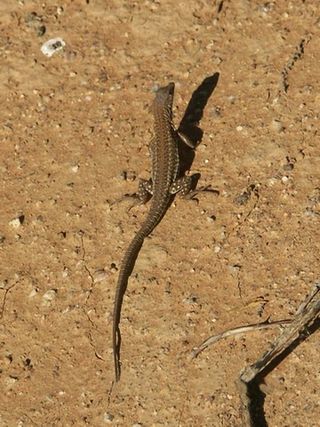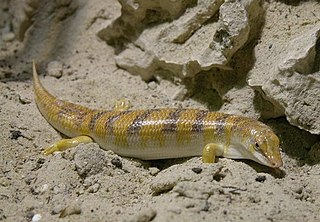
The Lacertidae are the family of the wall lizards, true lizards, or sometimes simply lacertas, which are native to Afro-Eurasia. It is a diverse family with at about 360 species in 39 genera. They represent the dominant group of reptiles found in Europe.

Fringe-toed lizards are lizards of the genus Uma in the family Phrynosomatidae, native to deserts of North America. They are adapted for life in sandy deserts with fringe-like scales on their hind toes hence their common name.

Meroles is a genus of lizards, commonly known as desert lizards, in the family Lacertidae. The genus contains eight species, inhabiting southwestern Africa, especially the Namib Desert.

Nucras is a genus of African lacertid lizards, commonly called sandveld lizards.

Scincus scincus, also commonly known as the sandfish skink, common sandfish or common skink, is a species of skink notable for its burrowing or swimming behaviour in sand. It is native to the Sahara Desert and the Arabian Peninsula, but is also kept as a pet elsewhere.
Ophiomorus tridactylus, commonly known as the three-toed snake skink, is a species of skink endemic to sandy desert areas of South Asia. It is also called the Indian sand-swimmer for its habit of moving just under the sand.

Eristicophis is a monotypic genus created for the viper species, Eristicophis macmahonii, which is endemic to the desert region of Balochistan near the borders of Iran, Pakistan, and Afghanistan. Common names for the species include McMahon's viper, Asian sand viper, leaf-nosed viper, and whiskered viper. Like all other vipers, it is venomous. No subspecies are currently recognized.
Chalcides sepsoides, the wedge-snouted skink, is a common and widespread species of skink in the family Scincidae. It is found in Tunisia, Libya, Egypt, Israel, Jordan, and the Palestinian territories.
The northern desert horned lizard is a subspecies of the desert horned lizard, along with the southern desert horned lizard. It is often referred to as a "horny toad" due to its wide body and blunt snout, but it is not a toad.
Meroles ctenodactylus, also known as the giant desert lizard, Smith's sand lizard or Smith's desert lizard, is a species of sand-dwelling lizard in the family Lacertidae. It occurs in westernmost South Africa and western Namibia.

Meroles squamulosa is a species of African lizard originally placed in the genus Ichnotropis, however phylogenetic evidence moves this species to the genus Meroles. The species is commonly called the common rough-scaled lizard or savanna lizard. It is largely found in southern Africa. These lizards are terrestrial and found in the range of mesic savannah. The common rough-scaled lizard is medium in size and well distributed in parts of Namibia, Botswana, Zimbabwe, Angola, Tanzania, and Zambia.
Saichangurvel is an extinct genus of iguanian lizards from the Late Cretaceous of Mongolia. It is a member of a clade called Gobiguania, an exclusively Late Cretaceous group of iguanian lizards that was likely endemic to the Gobi Desert. The type species, Saichangurvel davidsoni, was named by paleontologists Jack Conrad and Mark Norell of the American Museum of Natural History in 2007. It is known from a single nearly complete and fully articulated skeleton called IGM 3/858, which was found eroding from a block of sandstone during a thunderstorm at a fossil locality called Ukhaa Tolgod. IGM 3/858 comes from the Djadochta Formation, which is between 75 and 71 million years in age. Just as it is today, the Gobi was a desert during the Cretaceous. IGM 3/858 may have died in a collapsing sand dune, the rapid burial preserving its skeleton in pristine condition.
Monopeltis is a genus of amphisbaenians in the family Amphisbaenidae. Species in the genus are commonly known as worm lizards, even though they are not lizards. The genus is endemic to southern Africa. 19 species are placed in this genus.

Meroles knoxii, Knox's ocellated sand lizard or Knox's desert lizard, is a species of sand-dwelling lizard in the family Lacertidae. It occurs in Namibia and South Africa.
Meroles micropholidotus, the small-scaled desert lizard, is a species of sand-dwelling lizard in the family Lacertidae. It occurs in Namibia.
Meroles reticulatus, the reticulate sand lizard, is a species of sand-dwelling lizard in the family Lacertidae. It occurs in Namibia and Angola.

The spotted sand lizard is a species of lizard found in South Africa, Namibia and Botswana.
Pedioplanis rubens, called commonly the Waterberg sand lizard, reddish sand lizard, and (misleadingly) Ruben's sand lizard, is a species of lizard in the family Lacertidae. The species is endemic to Namibia.

The desert egernia, unadorned desert-skink or desert skink is a species of skink, a lizard in the family Scincidae. The desert egernia is endemic to the continent of Australia, and is widespread, with populations recorded in all mainland states and territories except the Australian Capital Territory. The desert egernia is found in dry, desert areas with deep, uncompacted sandy/loamy soils and little significant vegetation cover.








